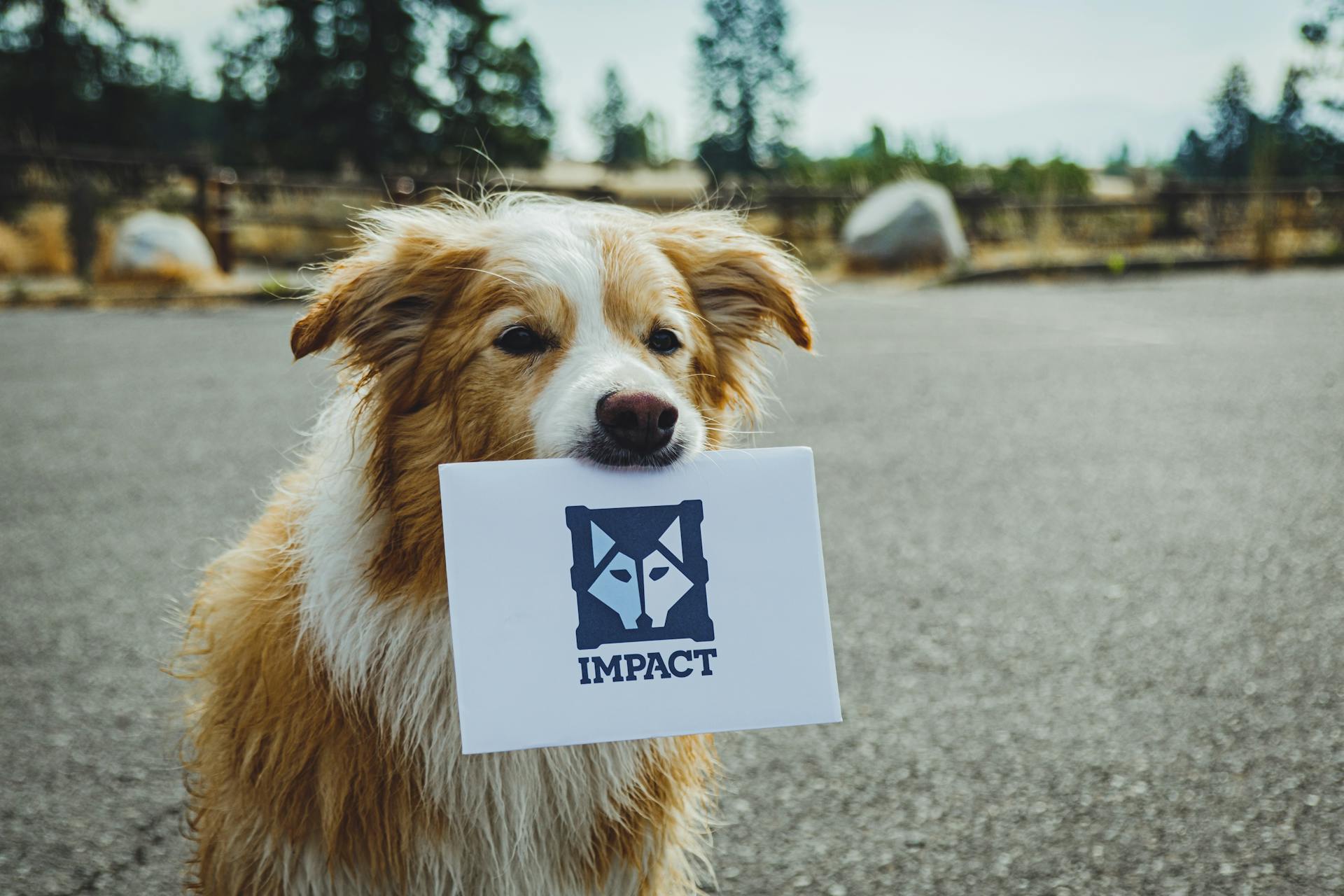
Dogs wag their tails for a variety of reasons, from excitement and happiness to anxiety and stress. A wagging tail is a natural form of canine communication.
The speed and movement of a wag can indicate the dog's emotional state. A rapid, wide wag often signals excitement or friendliness, while a slow, stiff wag may indicate anxiety or fear.
Dogs use their tails to convey emotions and intentions, making tail wagging a vital aspect of their nonverbal language.
If this caught your attention, see: Tail Wagging by Dogs News
Dog Behavior
Dogs wag their tails for various reasons, including excitement, anxiety, or even annoyance. It's essential to know your dog's typical tail behavior to understand their emotions better.
A dog's tail acts like a barometer for their mood, conveying emotions through its position and movement. Knowing tail positions and other canine body language cues will help you understand your dog and how to interact safely with other dogs.
Dogs respond to the tail wags presented by others of their species, and dogs seldom wag their tails while they are alone. Different colourations and patterns, like contrasting tips, are likely evolved to facilitate communication with the tail.
Broaden your view: Why Are My Dog's Nails Splitting?
A high tail full body wagging indicates a dog is in a state of arousal, often accompanied by a goofy grin and a wiggling motion. This means they are pawsitively elated about their surroundings, such as a homecoming or a walk.
Here are some common tail wag patterns and their meanings:
- High tail full body wagging: Excited, happy, friendly, welcoming
- Slow wag: Unsure and feeling insecure
- Tail held up higher than normal: Something has piqued their interest
- Tail lowered and between the legs: Fear, anxiety, or submission
Interpreting a dog's tail language accurately requires a holistic understanding of their emotional state. By understanding the anatomy, chemistry, and evolution behind tail wagging, we can forge deeper connections with our furry companions.
Explore further: Understanding Dog Behaviour
Emotions and Hormones
Oxytocin, the hormone associated with bonding and social interactions, plays a significant role in the strong bond between dogs and humans. It's released during positive interactions, such as when a dog wags its tail in response to our presence.
Cortisol, on the other hand, is the stress hormone that rises in situations making a dog feel uncomfortable or threatened. This can lead to physical and behavioral responses, including changes in tail position and movement.
A dog's tail wagging can be a positive sign if it's vigorous and in a relaxed environment, but if it's nervous or alongside signs of stress, it may indicate discomfort.
Oxytocin: The Love Hormone
Oxytocin is a hormone often associated with bonding and social interactions.
Studies have shown that dogs experience an increase in oxytocin levels when they interact positively with their owners. This is a two-way street, as humans also experience a release of oxytocin when interacting with their dogs.
The oxytocin feedback loop between dogs and humans contributes to the strong bond between them. This hormone is also released during breastfeeding and other intimate social interactions.
This deep emotional connection between humans and their furry companions is a powerful thing. It's a reminder that our pets are more than just animals, they're part of our families.
Cortisol and Stress
Cortisol is the hormone associated with stress and anxiety in dogs. It rises in situations that make a dog feel uncomfortable or threatened, leading to physical and behavioral responses like changes in tail position and movement.
A dog's tail wagging can be a positive sign in a relaxed environment, but if it's nervous or accompanied by signs of stress like panting or trembling, it may indicate discomfort.
Cortisol levels can cause a dog to feel uncomfortable or threatened, leading to a range of reactions. Understanding the interplay between cortisol and other hormones is key to interpreting a dog's behavior accurately.
Additional reading: Why Does My Dog Wag Her Tail
Sleep and Behavior
Dogs wag their tails while asleep, and it's not just a coincidence. This phenomenon has been observed in many dogs, and researchers are still trying to figure out why it happens.
Some experts believe that dogs dream during REM sleep, just like humans do. During these dreams, they may reenact activities they enjoy, such as playtime, which could trigger tail wagging.
Dogs are highly attuned to their surroundings, even while they're asleep. They may sense or hear something pleasant, like the approach of their owner, and respond with a wagging tail as a subconscious communication.
Tail wagging is a deeply ingrained reflex in dogs, and it's possible that their brain sends signals that trigger tail movements during sleep. This could be due to muscle memory, a trait that allows dogs to perform actions without even thinking about it.
Here are some theories that attempt to explain tail wagging in sleep:
- Dreaming of Play: Dogs may be reenacting activities they enjoy in their dreams.
- Subconscious Communication: Dogs may sense or hear something pleasant while they're asleep and respond with a wagging tail.
- Muscle Memory: Tail wagging could be triggered by signals sent by the brain during sleep, due to muscle memory.
Myth 3: A Always
A tucked tail can be a complex gesture, often misunderstood as solely indicating fear or submission. However, it can also signify discomfort or pain.
It's essential to consider the dog's overall demeanor and context when evaluating this gesture, as it can be influenced by various factors.
A dog's tail language is rich and nuanced, and a tucked tail can be a subtle sign that something is amiss, even if it's not immediately apparent.
Barking and Communication
Dogs use their tails to communicate with the world, expressing themselves through visual signals and pheromones.
Puppies start wagging their tails at around 30 to 50 days of age, a learned behavior from puppyhood that helps them communicate with other dogs.
A moving tail is a great visual cue to other dogs, especially since their eyes are very sensitive to movement.
Just as different human facial expressions mean different things, tail movements vary on how your dog is feeling.
A dog's tail acts like a barometer for their mood, with a lowered tail between the legs indicating fear, anxiety, or submission.
A slow wag can mean a dog is unsure and feeling insecure about a situation, while a tail held up higher than normal suggests something has piqued their interest.
The direction a dog is favoring when wagging their tail may be a mood indicator, with a wag on the right side of their body indicating relaxation and a wag on the left side suggesting alertness or anxiety.
A unique perspective: Separation Anxiety Symptoms Dogs
Tail Wag Patterns
Your dog's tail wag pattern is a clear indicator of their emotions. A wagging tail can mean your dog is happy and excited.
A slow, sweeping motion can indicate your dog is feeling calm and relaxed. This pattern is often seen in dogs that are well-trained and confident.
A rapid, staccato wag is a sign that your dog is overexcited or anxious. This is often accompanied by rapid breathing and a tense body posture.
A fresh viewpoint: How Often Flea Treatment Dog
Lateralization of Function
Lateralization of function is a fascinating topic when it comes to understanding dog behavior. The side bias of dog tail wags suggests a brain hemisphere lateralization that controls the movement of the tail.
Tail wags biased to the right are controlled by the left hemisphere, while left biased wags are controlled by the right hemisphere. This cross-over of descending motor pathways in dogs is crucial for their movements.
The rubrospinal tract is the primary pathway from the brain to the spinal cord. It crosses just caudal of the red nucleus and descends in the contralateral lateral funiculus.
Fibres of the rubrospinal tract then terminate on interneurons at all levels of the spinal cord. This complex system is responsible for controlling various responses in dogs.
The right hemisphere of the brain controls withdrawal responses, while the left side controls approach responses. This could be the reason for side bias of tail wags in different emotive situations.
High Full Body
High Full Body Wagging is a clear indicator of excitement and happiness in your dog. Their whole body may appear to be wagging, and they'll likely have an adorable, goofy grin on their face.
This type of wag is often accompanied by a wiggling motion, and the more they wiggle, the more positive their emotions are. You might see this wag when your dog knows they're about to go for a walk or play with you or another dog.
If your dog's tail is happy, it may wag in a circle, described as "the helicopter wag." This is a sign that your dog is pawsitively elated about something, and it's a great way to know how they're feeling.
Here are some possible emotions your dog may be experiencing when they display a high full body wag:
- Excited
- Happy
- Friendly
- Welcoming
Keep in mind that a high full body wag can also indicate that your dog is engaged with something in their environment, but without more context, it's hard to say what that arousal is.
Short Wavelength Tip
If just the tip of the tail is moving, or the tail is moving in a very short left-right wavelength, it indicates growing arousal and may indicate nervousness or uncertainty.
The rest of the tail must be stiff for just the tip to be in motion, which is a sign of mild arousal or stress.
This stiffness is a subtle but important clue to a dog's emotional state, and it's worth paying attention to if you notice it.
All Are the Same
As we explore the fascinating world of tail wag patterns, one thing becomes clear: all dogs are unique, but their tail wags share a common language.
Dogs wag their tails to communicate, and they can convey a range of emotions from excitement to anxiety.
The speed and movement of a tail wag can indicate a dog's mood, with a rapid wag often signifying happiness and a slow wag suggesting uncertainty.
A wagging tail can also be a sign of a dog's energy level, with high-energy breeds like Border Collies and Australian Shepherds often displaying rapid, energetic tail movements.
Broaden your view: When Do Dogs Lose Puppy Energy
Sources
- https://en.wikipedia.org/wiki/Tail_wagging_by_dogs
- https://www.smithsonianmag.com/smart-news/why-do-dogs-wag-their-tails-180983608/
- https://thevillagevets.com/blog/dog-tail-body-language/
- https://www.dognerdly.com/basics/body-language/why-do-dogs-wag-their-tails/
- https://www.akc.org/expert-advice/advice/why-do-dogs-wag-their-tails/
Featured Images: pexels.com


